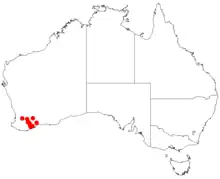| Acacia newbeyi | |
|---|---|
| Scientific classification | |
| Kingdom: | Plantae |
| Clade: | Tracheophytes |
| Clade: | Angiosperms |
| Clade: | Eudicots |
| Clade: | Rosids |
| Order: | Fabales |
| Family: | Fabaceae |
| Subfamily: | Caesalpinioideae |
| Clade: | Mimosoid clade |
| Genus: | Acacia |
| Species: | A. newbeyi |
| Binomial name | |
| Acacia newbeyi | |
 | |
| Occurrence data from AVH | |
Acacia newbeyi is a shrub of the genus Acacia and the subgenus Pulchellae that is endemic to an area of south western Australia.
Description
The openly branched and pungent shrub typically grows to a height of 0.3 to 1 metre (1 to 3 ft)[1] and has coarsely pungent and hairy branchlets. The leaves are more or less glabrous and composed of one pair of pinnae with a length of 1.5 to 2.5 mm (0.059 to 0.098 in) with two pairs of grey-green slightly thickened pinnules that have an oblong to obovate shape with a length 2 to 5 mm (0.079 to 0.197 in) and a width of 1 to 2 mm (0.039 to 0.079 in) which narrow asymmetrically at the apex.[2] It blooms from July to August and produces yellow flowers.[1] The rudimentary inflorescences are located on single headed racemes and have spherical flower-heads containing 10 to 13 pale yellow coloured flowers. Following flowering thinly leathery and hairy seed pods with a length of 2 to 3 cm (0.79 to 1.18 in) and a width of 3 to 4 mm (0.12 to 0.16 in) are formed. The glossy seeds inside have an oblong to elliptic shape with a length of 2 to 2.5 mm (0.079 to 0.098 in)[2]
Taxonomy
The species was first formally described by the botanist Bruce Maslin in 1975 as a part of the work Studies in the genus Acacia (Mimosaceae) - A Revision of Series Pulchellae as published in the journal Nuytsia. It was reclassified by Leslie Pedley in 2003 as Racosperma newbeyi then transferred back to genus Acacia in 2006.[3]
Distribution
It is native to an area in the Wheatbelt and Great Southern regions of Western Australia where it is found growing in gravelly lateritic soils.[1] The range of the plant extends from around Nyabing to near Boxwood Hill in the west to west of Ravensthorpe in the east where it is often a part of tall, occasionally open, shrubland communities that are often dominated by species of mallee.[2]
See also
References
- 1 2 3 "Acacia newbeyi". FloraBase. Western Australian Government Department of Biodiversity, Conservation and Attractions.
- 1 2 3 "Acacia newbeyi Maslin". Wattle - Acacias of Australia. Lucid Central. Retrieved 12 February 2021.
- ↑ "Acacia newbeyi Maslin". Atlas of Living Australia. Global Biodiversity Information Facility. Retrieved 12 February 2021.
